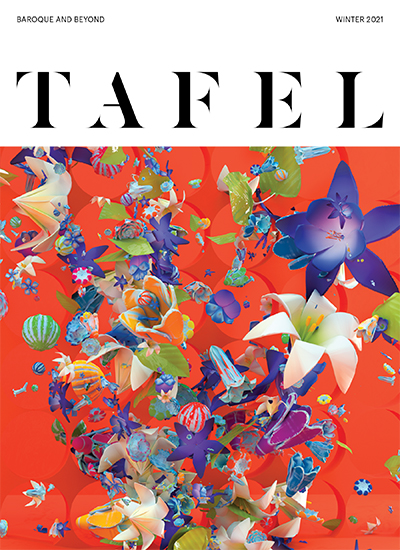Musik in Motion is a free series of collaborative videos, featuring local artists of diverse art forms, and produced by Tafelmusik and Puncture Design.
In keeping with Tafelmusik’s commitment to exploring “baroque and beyond,” we’ve invited five creative partners to interpret music that is an essential part of Tafelmusik’s signature repertoire. In our latest, we collaborated with visual artist Alex McLeod, who created a computer generated 3D sculpture, which moves, grows, and changes—all soundtracked by Mozart’s Requiem, K. 626: III. Sequenz, 6. Lacrimosa, as performed by Tafelmusik, Bruno Weil, and the Tölzer Knabenchor.
In this interview, get to know McLeod, his work, and his relationship with this piece of music.
Artist Alex McLeod. Photo by Glenn Lowson, the Globe and Mail.
Your video is a visual interpretation of a famous Mozart piece—Requiem, K. 626: III. Sequenz, 6. Lacrimosa—recorded by Tafelmusik. What words would you use to define the format, the medium, of this artwork? 3D modelling? Digital sculpture? Something else?
Alex McLeod: Sure. It’s a funny space, the virtual world: there is 3D modeling involved, but there is also lighting and camera and materials—so maybe calling it “digital animation” or “3D animation” is fine? Whatever Pixar uses, I’m fine with!
What drew you to this particular recording, as a source of inspiration for this artwork?
AM: A couple of reasons. It’s such a well-recognized song outside of the western classical community, so I felt it could be a great entry point for folks to explore other composers’ works within the genre—and maybe build a habit of viewing performances. The other reason is that it is shrouded in mystery, re-imagining, and death—which are all elements that fuel the inspiration for my visual practice. It felt very appropriate to explore, and who doesn’t want to make a music video for a legend like Mozart?
You collaborated with Tafelmusik once before, in 2021, for the cover of the second issue of Tafel Magazine. Prior to this, had you engaged with Tafelmusik at all—attending concerts, for example? And what drew you to this video project in particular?
AM: A dear friend of mine, Meghan Lindsay, performs with Opera Atelier, so I've had the pleasure of seeing a number of incredible performances featuring Tafelmusik. Through her, I’ve been able to work with musicians and composers—from early to new—on performance and video projects. There are parallels in my visual practice and Baroque music that compliment each other, at least I believe. Old and new, but more is more!
There are a lot of images and symbols present in your Musik in Motion piece: flowers, instruments, a linen motif. Can you speak a little about the symbolism of this imagery? This narrative?
AM: Flowers are such a beautiful archetype; they are spring, rebirth, optimism, and they are also death.They begin to fade soon after they bloom, we mourn with them, they grow above our bodies, and are fertilized from what came before them. The song is about death, but it's also about this same idea: when we perform it year after year it mimics the life cycle that all living things are a part of.
Generally, my work is very colourful. I’ve never really made a video that looked like this, it was a self-imposed challenge as much as a growth opportunity. Linen is such a loaded material: it’s behind almost every great painting, it can be wrapped around us in various ways while we live, and sometimes also when we pass away. It represents the unseen link between us.
There are also interpretations of instruments, and that’s where I started: I was going to explore our relationship to sound using the instrument that creates it. Then they began to form the visual architecture for the piece. You’re inside something or outside looking in: everything is covered in linen which disturbs our ability to set a context for where we are. Flowers bloom then fall — and before we know it, we're back at the beginning, but it’s different now, we are different.
Are there common themes, or narratives, throughout your work?
AM: I am very interested in the idea of interconnected matter, the air we breathe that has passed through the lungs of every soul that came before us. It’s such a humbling thought, that we will one day become a part of that nebulous ether. I like representing the natural world to relay that message. I like magic and things that we can’t explain, sometimes songs feel like magic. When certain frequencies play at certain times and we collectively react, it’s beautiful and mysterious.
What is your artistic approach like, in terms of process, for a project like this? Do you begin with a sketch, a plan, or do you dive in and let your imagination guide you as you go?
AM: I listened to the piece endlessly, hoping that it could drive the approach. I am very process-driven, and things can change dramatically when I’m working, so for this it was important to clearly direct the flow and look of the work before it was made — otherwise who knows what could have happened!
Can you speak a little bit about the software you use?
AM: It’s developed for animation, product visualization, architecture, and anything in between. I studied painting in my undergrad but was never particularly good at the execution, so learning the tools I use has freed me of the obstacles I faced working in painting. I’m also tremendously lazy, so if I had painted the background one colour but ended up wanting it a tint different, I just wouldn't bother — but with this software, I can change the colour, texture, and lighting by adjusting a few parameters. I’m very lucky to have found my instrument.
You recently directed and animated a music video for another Canadian artist: the late Gord Downie, of The Tragically Hip. Can you tell us a little more about this project, and how it came to be?
Gord is another legend, it was truly a great Canadian moment to make this piece for him. Sara Basso approached me about making a video for the album and had the vision. Gord’s father was a traveling salesperson: it's not a career we hear much of anymore, always on the road, motels, isolation, and freedom. It’s somehow appropriate with the pandemic, folks not being able to go anywhere but many of us were free to explore other facets of ourselves and interests. All that to say, I was really into the idea of researching vintage motel rooms, and crafting a piece that began and ended there. Nature overtakes the room — like the lyrics in the song, “I don't care about nature, Nature don't care about it” — and in the end we die, and the cycle continues.
Are there any particular art movements, or artists, who inspire you most? What living artists should we be paying attention to right now?
This list of artists to pay attention to right now would be too long, so I will offer this. There are a tremendous number of visual artists here in Toronto, but we are siloed, just like most disciplines, unfortunately. Art Toronto is our art fair, and it’s a great starting point to find out about galleries that show works that speak to you. I feel like that's a solid approach, start with art fairs, then galleries, then artists: then, when you find artists that you like and find them on social media, you can often see other artists in their community or peer group that might have commonalities to the traits you liked about the work. It can become a rich and mesmerizing journey.
Can you share if and how the pandemic has affected your artistic practice?
I used to travel for exhibitions, and that face to face is important. I feel like opportunities can happen more frequently when you’re easily available. Many shows have been postponed or canceled, but many other opportunities happened because of it. I have tremendous gratitude for where I am in this world, and the pandemic has really helped me build that.
Do you have any projects or exhibitions coming up we can learn more about?
Necroflora opened on April 9, and runs until May 8, 2021: learn more at galleryjones.com
Watch Mozart Requiem, K. 626: III. Sequenz, 6. Lacrimosa with Alex McLeod from Musik in Motion below.


